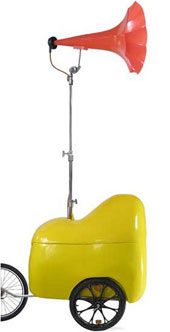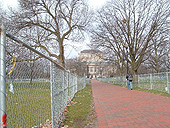:: Wednesday, June 08, 2005 ::
ART AND MOBILE TECH::PROJECTS REVIEW::
Speakers Corner Revisited or Sound and Free Speech in the City
BY::Ana Boa-Ventura
Its authors call it a mobile sculpture. One Free Minute
relies on a sculptural object that looks like one of those tabletop vintage record players. This project is about public discourse, and the ways in which it has been affected by technology. It turns the private world of the cell phone up on its head, and adds an element of 'free speech'. The first performance date: Friday June 3, 5-7PM EST, at the Oval of the Ohio State University.
When you call One Free Minute's cell phone you are connected to an amplifier and your 'speech' is projected in real-time if you call during one of the projected performances; if you decide to call prior to the performance your words will play randomly between the other live calls. Each recorded or live call lasts exactly one minute. Other audio installations specifically targeting free speech, cellulars and the urban space are being performed in other cities with varied artists. The Spanish group La Fura dels Baus were one of the first to incorporate cell phones in their performances and project the words that some 300 people sent via SMS. This happened during performances in Barcelona and Valencia. Some messages insulting the Mayor of Valencia led to an inquiry in the days that followed the piece, and apparently 'senders' were not 'traceable', though this is an area of mobile telephony very much underexplored in terms of what is actually surveilled and what is not.
Other audio installations specifically targeting free speech, cellulars and the urban space are being performed in other cities with varied artists. The Spanish group La Fura dels Baus were one of the first to incorporate cell phones in their performances and project the words that some 300 people sent via SMS. This happened during performances in Barcelona and Valencia. Some messages insulting the Mayor of Valencia led to an inquiry in the days that followed the piece, and apparently 'senders' were not 'traceable', though this is an area of mobile telephony very much underexplored in terms of what is actually surveilled and what is not.
Considering historical loci of public speech, Speakers' Corner in London's Hyde Park first comes to mind. There have been several 'digital versions' of this place, such as www.speakerscorner.org.uk, which takes a 'live feed' from the website or your mobile phone and feeds it directly to a public screen at the Media Centre, in Huddersfield, UK. Jaap de Jonge developed the concept.
In the Sonic Memorial Project, sounds, music, and voice, collected by an answering machine left at Ground Zero, where the artists worked for several months, are representative of private memories about the World Trade Center disaster, and become a collective memory on the web. The emphasis is more on memory and less on 'freedom of speech' but 'freedom' is definitely a theme in the memories.
In sum, One Free Minute questions ideas of surveillance, 'free speech', and public space. Others have explored this idea, as well. La Fura and their experimentations with Instant Messaging during their performances, Speakers' Corner with the digital translation of the notorious London site and theSonic Memorial Project with its collection of recorded memories about an unforgettable place, the destruction of which marks a new era in 'national security.'
Speech, in these artistic contexts, may be a new expression of the Roman idea of civitas (city) for which public speech was fundamental. In One Minute Free and other projects discussed here, 'public' is replaced by 'free'; notably the speech still takes place on a square (the Ohio University's Oval, a square in Spain, downtown Huddersfield) but it is now mediated through technology and dislocation and its source is a 'citizen' that talks (or 'short messages') in a situation of anonymity.
These are three explorations of sound through performances and/or installations that put the emphasis on different modalities of the private, the public and that which is 'urban'.
Websites:
One Free Minute: http://www.onefreeminute.net
Fura Dels Baus: http://www.lafura.com/entrada/index2.htm
Speakers' Corner: http://www.speakerscorner.org.uk/
Jaap de Jonge: http://www.jaapdejonge.nl/
Sonic Memorial Project:
http://www.sonicmemorial.org/sonic/public/index.html